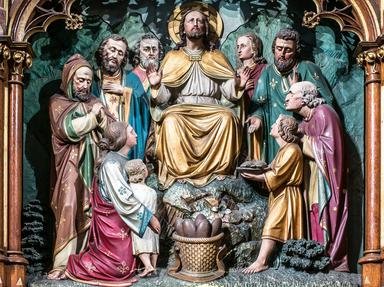Quiz Answer Key and Fun Facts
1. One of the best known artworks is Michelangelo's painting on the ceiling of the Sistine Chapel. In the centre we see two persons whose fingers almost touch. Who are these biblical characters?
2. Pieter Bruegel the Elder painted twice (in 1563 and in 1564) a large tower in construction, with several people just in front of it. According to the painting's title and to the biblical story, where did someone try to build this tower?
3. The following scene is from a bas-relief in the doors to the Florentine Baptistery. Lorenzo Ghiberti has depicted here a scene with a bearded man about to strike a nude young child, when an angel of the LORD appears and stops the elderly man in the action. Furthermore on the bas-relief is a ram, as well as a servant tending a saddled horse and someone harvesting grain. For those who know the story: some of the people and animals depicted are not quite to the point... Who is the bearded man stopped by an angel?
4. Tintoretto completed a painting with a young woman ("dressed" in only a pearl necklace) grasping the coat of a young man, trying to escape her advances. Whose wife do we see in this painting?
5. Philippe de Champaigne might be not the most famous painter, but one of his subjects is quite recognisable. A bearded man seeming to have a shiny face, and dressed in exquisite robes, holds a reed in his right hand. More important is the stone slab in his left hand, with some writing engraved. Who is depicted here?
6. Nicolas Poussin painted a scene full of people, but most important in this scene is a gold coloured statue. We see a man in a white tunic pointing out the statue, a host of men coming to adore this idol, some women with infant children trying to get a blessing from the statue, and a quartet of singing and dancing people. On the right side we can barely recognise an old man coming down from a mountain. What is the statue in this painting?
7. In one of the least famous paintings by Rembrandt, a donkey lies down on all fours. A bearded man is about to strike the poor animal with a long rod, while an angel with a sword is ready to give a capital blow - not to the donkey, though. Who is the brute trying to hit his donkey?
8. Giambatista Tiepolo decorated the ceiling of the Sala Rossa in the Palazzo Arcivescovile (Palace of the Archbishops) with a very moving painting. To the right, we see a king on an ivory throne, surrounded by several people (of whom a fat man in a white tunic with a green cape attracts all the attention). In the front, we notice a dead baby, white as chalk. But the most dramatic event is situated on the left: a soldier with a drawn sword holds a nude baby upside down. A lady in a green robe watches with some concern, and a woman in a white robe and blue cape seems to beg for mercy. Who is the king depicted?
9. Rubens is one of the most prolific Baroque painters. In one of his paintings on canvas, we see a young man dressed in a loincloth (sitting on a red robe) and eight or nine big cats. What is the title of this painting?
10. The disputed chapter Daniel 13 contains a story illustrated by (among others) Artemisia Gentileschi. We see a nude young lady having taken a bath, with part of her left foot still in the water, when two men spy upon her. One of the men is hardly recognisable, the other is bald and bearded. Who was spotted by two men when she came out of her bath?
Source: Author
JanIQ
This quiz was reviewed by FunTrivia editor
CellarDoor before going online.
Any errors found in FunTrivia content are routinely corrected through our feedback system.

